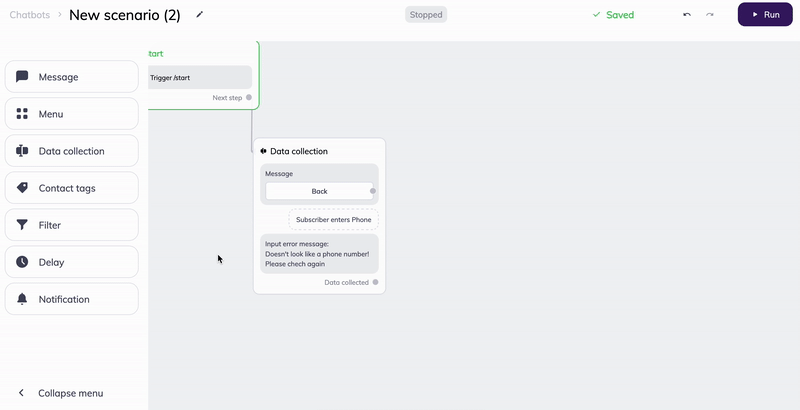You open a website and something in the bottom-right corner pops up with a bleep. That’s a chatbot demanding your attention. It’s likely you, as many of us, find chatbots annoying, and yet so many businesses and organizations have them now.
So, what is a chatbot? Is it just a silly robot or does it bring benefits to both businesses and their customers? How do chatbots work? When will they be most helpful, and what are the options available on the market? These are the questions we answer in this article.
What is a chatbot?
A chatbot is a computer program or an artificial intelligence (AI) system designed to simulate a human conversation. They are typically used in various applications to interact with users through text or speech in a natural language, providing information, answering questions, and performing tasks.
Do not confuse chatbots with malware. Bots, as an entity, have got a bad reputation for being used in hacker attacks. Chatbots are merely tools to facilitate communication between businesses and customers. For the sake of brevity, chatbots are often called bots too.
Microsoft researcher Jonathan Grudin divides all chatbots into three major categories: task-focused, intelligent assistants and virtual companions.
| Capabilities | Used in | Example | |
| Task-focused | Limited | Ecommerce, digital marketing | Facebook bot for a pizza company |
| Intelligent assistant | Average to impressive | Mobile phones, banking | Siri, Alexa, Google assistant |
| Virtual companion | A+ | Psychotherapy, AI research | Cleverbot, ELIZA |
The majority of businesses only ever use task-focused chatbots, so we’ll be covering mainly them in this article.
How do chatbots work?
A chatbot receives information in a request and it has to return a satisfying answer. To do the latter, it has to understand a request. How to make sure this happens?
Task-focused chatbots work according to a predefined script. They are meant to automate routine tasks, such as order tracking or appointment scheduling, and reduce the need for human intervention. The more you know about your customers and their needs, the better you can set up your bot and provide your clients with the best solutions.
More sophisticated bots powered by Machine Learning and Natural Language Processing can analyze large amounts of data and learn from it, which allows them to handle a wide range of conversations.
Four main ways businesses can benefit from using chatbots
Chatbots can be a handy replacement or extension of a customer support team but they can also make money. Here are the four major ways businesses can benefit from using a chatbot.
Provide customers with 24/7 support
A chatbot can provide users with answers they might be looking for. For example, it can handle the most frequent questions about the product, help with password reset, provide contact information, etc.
The speed of response matters a lot. In fact, 64% of people, who participated in the recent study on consumer patience, said speed is as important as price. 54% said that speed and responsiveness are also very important when they need to get help with the product or service they purchased.
Since chatbots don’t sleep, they’re available to customers all the time. Not many companies can afford a support team, let alone one that works 24/7. A chatbot won’t keep clients hanging with their requests on holidays or at 3 AM.
Reduce customer service costs
A chatbot can partially or fully replace customer support and thus save a lot of money, especially if you fully automate customer support.
But even if you have no intention nor need to completely replace your support team, you can still use a chatbot to handle requests like “track my order” or “how can I pay.” With a chatbot at hand, your support team will be able to focus on more complex issues.
Use chatbots as sales channels
Customers no longer need to make calls to order a pizza or a taxi. Instead, they can do it through chatbots that give a list of options to choose from or let customers type a request. This is a win-win situation because it saves time for both companies and their clients.
Clothing, software, and electronics brands also use chatbots to introduce their products. If a chatbot is integrated with a payment service provider, customers can complete purchases without leaving the bot.
No wonder that in 2023, the global market for chatbots is worth $5.5 billion. By 2028, the figure is estimated to triple to $15.5 billion.
Generate leads
Chatbots can turn random people visiting your website into new clients.
All you need to do is to enable the bot to proactively start a conversation. Program the bot to offer a discount, a free resource, or a limited-time offer. To get it, the person will have to disclose a phone number or an email to the bot.
So, even by guiding visitors through a scripted conversation flow, chatbots can collect leads and enlarge the brand’s client base.
Most common types of chatbots
While the majority of chatbots used in digital marketing are task-focused, we are also going to mention conversational chatbots in this section to give you the full picture.
Menu-based, or button-based chatbots
Menu-based chatbots are the most basic chatbots. They follow a script — a set of limited predefined commands. What a user clicks on determines the next set of commands.
Menu-based chatbots can’t learn through interaction with people or data. The only way to improve them is by adding more possible sets of commands or editing out inefficient scripts.
Menu-based chatbots are great solutions for simple routine tasks. For example, they can help navigate a website, make a quick order, complete the purchase, or contact a support agent. They can also offer lead magnets in exchange for contact details.
Keyword recognition-based chatbots
In principle, keyword recognition-based chatbots operate the same way as menu-based ones but there’s more freedom of action on the user’s side.
Instead of just clicking buttons, users can also type words. A chatbot picks up keywords, and starts searching for scripts that can be triggered to give a response.
Keyword recognition-based chatbots are often combined with menu-based ones. It makes sense to provide users with both input options of input since clicking saves time.
Keyword chatbots with a menu are popular on Facebook. Here’s one example:
If you set up a keyword chatbot you need to map out as many user scenarios as possible because, outside the script, such a chatbot is useless.
Keyword chatbots are also a good opportunity to learn about your customers if you can spot trends in user requests.
Machine-learning and voice-enabled chatbots
Machine-learning chatbots are somewhat similar to keyword-based chatbots. What sets them apart is their ability to learn from repeated interactions. The more data it collects, the more intelligent it becomes. However, for a machine-learning chatbot to work effectively, one needs a staggering amount of data and a team of engineers and data scientists.
Machine-learning chatbots are also known as conversational or contextual chatbot and are especially popular in the banking sector playing the role of virtual assistants.
In 2018, Bank of America released a virtual assistant Erica to help their clients manage money. What makes Erica is her ability to recognize human voices and speak back in addition to interactions via text messages. Erica can schedule payments, updates customers on their spending, and show recent transactions. She can even raise safety concerns if she notices a drastic increase in spending.
Erica is a highly intelligent chatbot and as of 2023, it has over 37 million users.
While machine learning chatbots are a fantastic technology, they might not be worth the fuss if you need a chatbot to cover the basic ecommerce needs, that is cutting costs and boosting sales.
What is worth the fuss in digital marketing in 2023 is personalization, segmentation, responsive emails, and a bunch of other things — find them in our list of email marketing tips.
Generative chatbots
Generative chatbots use a broader range of data than machine-learning chatbots, generating responses based on learned patterns rather than specific data or scripts. This is how they are able to answer almost any question and maintain a coherent conversation, regardless of the topic.
ChatGPT is the most well-known generative chatbot, and thanks to OpenAI’s API it can be easily integrated with other chatbots, apps, and services.
To give you just one example of such integration: in 2023, Expedia launched an in-app travel planning experience powered by ChatGPT.
Hybrid chatbots
Hybrid chatbots combine a chatbot and a live chat with a support agent in one interface. They come last on this list but they are probably one of the best solutions for digital marketers looking to employ chatbots.
In the hybrid model, a chatbot steps forward and tries to deal with a request but if it can’t, a human assistant takes over the conversation.
You may be wondering — why not redirect customers to human support agents straightaway? There are at least two good reasons for it.
First, not all businesses can afford a support team, that works 24/7. Add to that the problem of many languages for multinational companies. Second, the majority of user questions are easy enough for a chatbot to answer, meaning the customers won’t have to wait to get the information they need.
Choosing the right platform for your needs
Chatbots can be added to a website, integrated into a social media platform or have their own app.
A lot depends on where your customers spend their time. If they use WhatsApp, you should configure your brand’s bot for this messenger. Or if they use WhatsApp, Telegram, Facebook and Instagram all at once, you’ll need a chatbot that will work across multiple channels.
Below is our list of five services where you can create and launch a chatbot without having to learn how to code.
Selzy
Best for: email marketers and business owners who want to go beyond email at no additional cost
Pricing starts at: $11/month or $126/year when paid annually. Selzy’s chatbot builder is included in the Standard plan.
Selzy is an email marketing automation platform that also allows its users to create chatbots for Telegram.
If you wonder why Telegram, you probably don’t know that it’s one of the top 3 messengers globally. It has 500+ million active users per month and, what’s even more important, an 80% message open rate.
Chatbots created with Selzy can respond to user messages, commands, and actions or connect a human support agent to pick up the conversation.
They are perfect for marketing activities since they can collect contact information, flag the leads, and use that information later to send notifications about new products or promotions.
Selzy’s chatbot builder is super-intuitive, allowing drag-and-drop elements with different functionalities to create multiple scenarios within one chatbot.
ManyChat
Best for: driving sales and conversations on messaging apps
Pricing starts at: $15/month, but a free plan with limited options is also available
Manychat allows you to build simple task-focused chatbots. The drag-and-drop editor (no coding required!) and a set of predefined templates make it a quick experience.
The chatbots support integrations with ESPs and SMS but the main focus is messengers: Facebook Messenger, Instagram DMs, and WhatsApp.
Create automated conversations in order to drive sales and get more leads through ManyChat’s chatbots. You can also accept payments thanks to the integrations with PayPal and Stripe.
Chatfuel
Best for: e-commerce businesses who aim to boost their revenue on WhatsApp
Pricing for WhatsApp chatbots starts at: $34.29/month, but they have other plans going as low as $11.99/month
Chatfuel can be a good alternative to Manychat as they also build chatbots for Instagram and Facebook. However, their main focus is WhatsApp.
Thanks to Chatfuel API, businesses can integrate data from their store, CRM, or CDP.
Chatfuel offers both ready-made and custom solutions while inviting businesses to supercharge their communication with ChatGPT.
The drag-and-drop editor is intuitive and the developers added 60 templates across 16 industries for the most popular scenarios.
SendPulse
Best for: accepting payments worldwide
Pricing starts at: $8/month when paid annually, but a free plan with limited options is also available
With SendPulse, you can create chatbots for all popular messengers — Facebook, WhatsApp, Telegram, Instagram DMs, Viber — and a website.
These chatbots are triggered by keywords. A user types a request and receives a quick automated response.
Sendpulse is also ChatGPT ready, meaning your chatbots can help your customers with simple tasks like searching for SEO keywords or generating slogans in addition to providing scripted responses.
The SendPulse developers also created a mobile app to manage chatbots created for different messengers in one place. Use it to communicate with your customers, manage chats, work with subscriber data and check chatbots statistics.
Probably, the best thing about SendPulse is the variety of payment service providers that they integrate with to enable closing sales right in a chatbot. In addition to PayPal and Stripe, they also support Mercado Pago and Flutterwave.
SnatchBot
Best for: building omnichannel and hybrid chatbots
Pricing starts at: $79/month when paid annually, but a free plan with limited options is also available
SnatchBot is a bot builder platform for businesses and developers, boasting a large variety of integrations, their own bot store, large library of templates, and text-to-speech capabilities available in over sixty languages.
One disadvantage is the bot builder itself. While SnatchBot assures their website visitors that no coding or technical skills are required to build a bot, their builder isn’t exactly beginner-friendly with a seemingly umpteen number of features and settings.
FAQ: What you need to know about chatbots
What is a chatbot?
A chatbot is a computer program or AI system that simulates human conversation. Businesses use them on websites, messengers, or apps to answer questions, guide users, and automate routine tasks. Unlike harmful “bots” used in hacking, chatbots are simply tools for communication.
How do chatbots work?
Most business chatbots follow a predefined script to handle frequent requests like order tracking, password resets, or booking an appointment. More advanced bots use machine learning and natural language processing to understand free-form questions, learn from data, and respond more naturally.
What types of chatbots exist?
The most common are menu-based bots with buttons, keyword recognition bots that detect typed phrases, and machine-learning bots that improve through repeated interactions. More recent options include generative AI chatbots like ChatGPT and hybrid bots that combine automation with a handoff to a human support agent.
Why should businesses use chatbots?
Chatbots provide instant 24/7 support, reduce the workload and costs of human support teams, and help increase sales. They can guide customers through purchases, offer discounts in exchange for contact details, and even generate leads by collecting emails or phone numbers during a conversation.
Where can I use a chatbot?
You can place a chatbot on a website, integrate it into a messenger like Telegram, WhatsApp, or Facebook Messenger, or even build one into a mobile app. The choice depends on where your customers spend most of their time. For businesses targeting audiences on multiple channels, omnichannel chatbots are a smart choice.
Which chatbot platforms are available?
There are many no-code builders that make chatbot creation accessible without programming. Selzy, for example, includes a chatbot builder in its email marketing platform for Telegram. Other options include ManyChat for Messenger and Instagram, Chatfuel with a focus on WhatsApp, SendPulse for multichannel support, and SnatchBot for hybrid bots.
Are chatbots difficult to set up?
Most modern chatbot builders are drag-and-drop tools with ready-made templates. That means you can launch a working chatbot in just a few steps — define your scenario, add conversation blocks, and connect the chatbot to your preferred channel.




















